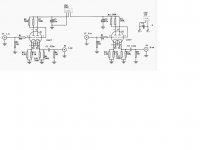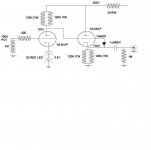Hey all,
I found a bunch of 5963 tubes at work (apparently 6.3v heater versions of 12AU7) and decided to build the attached schematic. With 250V B+ and the heater ground has been lifted about 70V.
Now the question, I have run through 3 tubes where the back side of the tube (plate pin 6 and cathode pin 8) have died after a couple hours. I have confirmed the backside of the dual triode (pin 6/7/8) is dead with a Tube tester. All I can think is that I possibly exceeded the Heater Cathode Voltage. Is this what happens when you exceed the max heater to cathode voltage?
The 5963 Heater pos/neg to cathode max voltage is 90V/90V, and I am right at 87V/80V after tweaking.
The intended tube is the 12AU7 which has a max heater pos/neg to cathode max voltage of 180V/180V...
I found a bunch of 5963 tubes at work (apparently 6.3v heater versions of 12AU7) and decided to build the attached schematic. With 250V B+ and the heater ground has been lifted about 70V.
Now the question, I have run through 3 tubes where the back side of the tube (plate pin 6 and cathode pin 8) have died after a couple hours. I have confirmed the backside of the dual triode (pin 6/7/8) is dead with a Tube tester. All I can think is that I possibly exceeded the Heater Cathode Voltage. Is this what happens when you exceed the max heater to cathode voltage?
The 5963 Heater pos/neg to cathode max voltage is 90V/90V, and I am right at 87V/80V after tweaking.
The intended tube is the 12AU7 which has a max heater pos/neg to cathode max voltage of 180V/180V...
Attachments
Take one of these bad tubes and measure the voltages on all pins in circuit, and do the same with a known good one - the answer should then be quite obvious.
Failure under the conditions you describe is possible, but I have not run into too many cases where the failure was this extreme or rapid.
I would obviously recommend you get some 12AU7A/6189/5814 fairly soon.. (Watch the cathode/filament ratings though)
Failure under the conditions you describe is possible, but I have not run into too many cases where the failure was this extreme or rapid.
I would obviously recommend you get some 12AU7A/6189/5814 fairly soon.. (Watch the cathode/filament ratings though)
One thing to keep in mind with cathode follower... The cathode to heater difference is the sum of the AC signal voltage and DC voltage... You have the DC voltage difference which it looks like you accounted for...you need to add half the AC signal rms value to this.... or half of the max voltage swing you get from the gain of the first stage...
Chris
Chris
The heater and cathode are close together. My assumption is that exceeding the Vhk spec would lead to dielectric breakdown of whatever separates the heater from the cathode. Arcing would result. I doubt it would be enough to physically break the tube, but it would certainly screw with the performance and would likely strip off any coating on the heater or cathode, thus, making matters worse.
Those are my thoughts on the topic anyway.
~Tom
Those are my thoughts on the topic anyway.
~Tom
With a fresh tube, I get 128V on cathode (pin 8) and 250 at plate (pin 6)...After a few hours of play with no issues, I shut the preamp down and go to bed.
The next day I start the pre and no or very low output. I open up the pre and check voltages and that Pin 8 cathode voltage is either 60V-70V or 0V, and 250V on plate.
I have gone through three 5963 tubes already. On tube tester, front side triode is fine, back side triode is dead.
The next day I start the pre and no or very low output. I open up the pre and check voltages and that Pin 8 cathode voltage is either 60V-70V or 0V, and 250V on plate.
I have gone through three 5963 tubes already. On tube tester, front side triode is fine, back side triode is dead.
You could rearrange things so one tube does the left and right channels of the bottom triodes, and the other tube does the top triodes. And feed both with separate heater supplies biased to close to where the cathodes will be operating at. Maybe (thinking out loud here, so this may or may not be a good idea) you can use a resistor of a few 100K's between the top triode cathode and the heater, and bypass the heater side of that resistor with a cap to ground. This will make sure that the heater bias always track the cathode voltage, if the time constant of the RC is long enough to smooth out the 60Hz AC heater supply (oh wait, you're using DC so that issue should go away) but short enough to allow the cap to charge up fast enough to let the heater bias track the cathode when it's heating up.
Connect a diode between the grid and cathode of the cathode follower section. The diode's cathode (the end with the stripe) shoind be attached to the tube's cathode. Then see if your tubes survive the rigors of turn on and turn off.
Sy, Will a 1N4001 work OK? Connect from pin 7 to pin 8 (Diode of cathode to pin 8)
You think its a turn on/off inrush problem?
Last edited:
Tomer - "Getting the Most Out of Vaccuum Tubes" has a good description of the issues.
http://www.pmillett.com/Books/intro_Tomer_1960_Getting_the_Most_Out_of_Vacuum_Tubes.pdf
http://www.pmillett.com/Books/intro_Tomer_1960_Getting_the_Most_Out_of_Vacuum_Tubes.pdf
Sy, Will a 1N4001 work OK?
Actually, the 1N4001 is only good for 50V...I need the 1N4004 - 1N4007. I think I have quite a few somewhere...
Boy am I embarrassed...after further review (and a look at the data sheet) the 5963 requires 12.6V on heaters. Of course I found this out after I soldered in the 1N4007 diodes as Sy suggested...ahh, was working working fine after the heater correction and diodes...I was wondering why the heater filaments looked kinda dim (not unlike me)....still don't know how I killed those three 5963 tubes tho....
Anyway, not able to leave well enough alone (again), I reconfigured the circuit to accommodate the 6N1P tubes I had...I already had the heaters all set up for DC, so a quick check and a resistor change, I now have a good 6.3VDC on the heaters. Anyway, she sounds very nice now. Here is the final circuit (I won't mess with it again). I wish I had a nice 6N1P plate-grid graph, but all I find on the internet is crappy diagrams that are hard to read and are inconsistent.
I believe the 6N1P has 11k plate resistance and I have a 62k plate load, so this should be good to go. Not much current through the tube (1.3ma), but I am hapy with what I now have. It sounds yummy...
Any opinions would be welcome...
Anyway, not able to leave well enough alone (again), I reconfigured the circuit to accommodate the 6N1P tubes I had...I already had the heaters all set up for DC, so a quick check and a resistor change, I now have a good 6.3VDC on the heaters. Anyway, she sounds very nice now. Here is the final circuit (I won't mess with it again). I wish I had a nice 6N1P plate-grid graph, but all I find on the internet is crappy diagrams that are hard to read and are inconsistent.
I believe the 6N1P has 11k plate resistance and I have a 62k plate load, so this should be good to go. Not much current through the tube (1.3ma), but I am hapy with what I now have. It sounds yummy...
Any opinions would be welcome...
Attachments
Last edited:
Going back to the heater cathode issue: Something like a neon bulb connected between the cathode and the heater may do what you need. The neon bulb doesn't conduct until the voltage across it gets to about 90V, and then clamps that voltage to about 60V. As heater cathode specs usually say "no more than 100V" that should work. During normal operation the bulb will just look like a 1pF cap. Just be sure that the neon bulb and circuits around it can't dump more than around 1ma of current when the bulb does turn on. Like a zener diode.
- Status
- This old topic is closed. If you want to reopen this topic, contact a moderator using the "Report Post" button.
- Home
- Amplifiers
- Tubes / Valves
- What happens when Heater Cathode voltage is exceeded?

